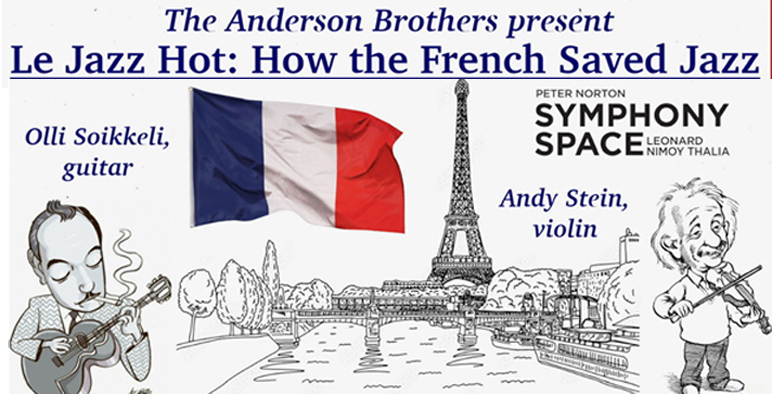France’s welcome to American jazz – Edifying and Entertaining
By Alix Cohen
After World War I, American jazz musicians—many of them Black expatriates—found a welcoming audience in Paris. The Hot Club de France, founded by Django Reinhardt and Stéphane Grappelli in 1931, formalized jazz appreciation and promoted the genre as serious art. Le Jazz Hot was not just a musical style—it was a cultural phenomenon that symbolized modernity, sophistication, and artistic freedom in 20th-century France.
I first reviewed the Andersons thirteen years ago. Though both sit in with other bands, write and arrange, and Will has written a book, this wonderful series continues to be a highlight. Live music with still and film visuals as well as brief narration make the programs exceptional.
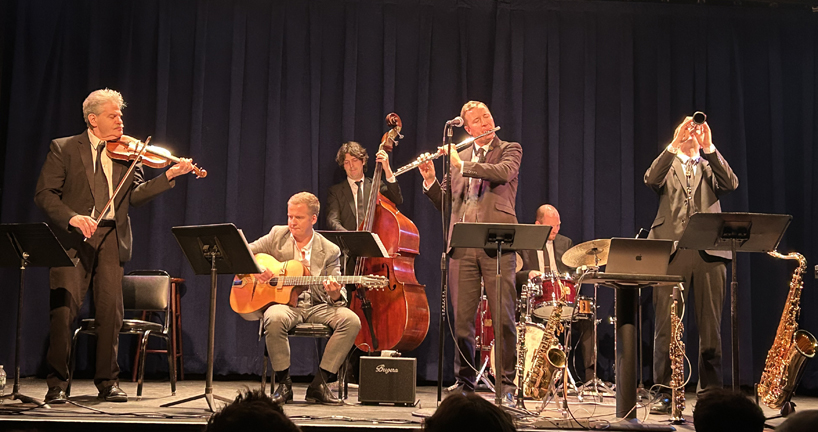
Andy Stein, Olli Soikkeli, Daniel Duke, Will Anderson, Alex Raderman, Peter Anderson
Walter Donaldson’s “You’re Drivin’ Me Crazy” gleefully swings in as if musicians were at a playground. Olli Soikkeli’s guitar solo is fleet-fingered and meticulous.The song was introduced by “Black Venus” Josephine Baker, a young African American who took Paris by storm, loosely dancing in as few garments as possible. Her banana skirt is legendary.
Baker would go on to earn more money than any entertainer of her time, adopt (not always legally) 12 “rainbow children”, and work for the French Underground.
“C’est si bon” (Henri Betti/André Hornez), driven by clarinet and soprano sax, arrives round-edged with conversation between the two swirling instruments. A record album cover as performed by Louis Armstrong is shown. “The first two songs are musical hors d’oeuvres,” Will Anderson begins.
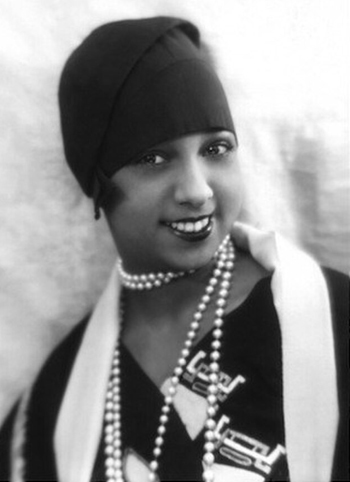
Josephine Baker 1930 by Paul Nadar
(Public Domain)
Early practitioner Sidney Bechet was an American saxophonist and clarinetist whose emotionally charged style and charisma made him a cornerstone of French jazz. Bechet was one of the genre’s first major soloists, recording even before Louis Armstrong.
“Promenade aux Champs-Elysees” (Sidney Bechet) is jaunty Flâneur music. Notes emerge so swiftly they overlap. Bechet’s “Si tu voir ma mere” (if you see my mother) follows longlined, swaying like a hammock, reflecting the composer’s New Orleans origin. “When the French once love you, it’s forever, not so the United States.” Dizzy Gillespie 1982
A Romani guitarist who pioneered Gypsy jazz with iconoclastic technique and harmonic sophistication, Django Reinhardt went from “playing guitar and stealing chickens” (while living in campgrounds), to making guitar a lead instrument, rather than just rhythm support, Will tells us.
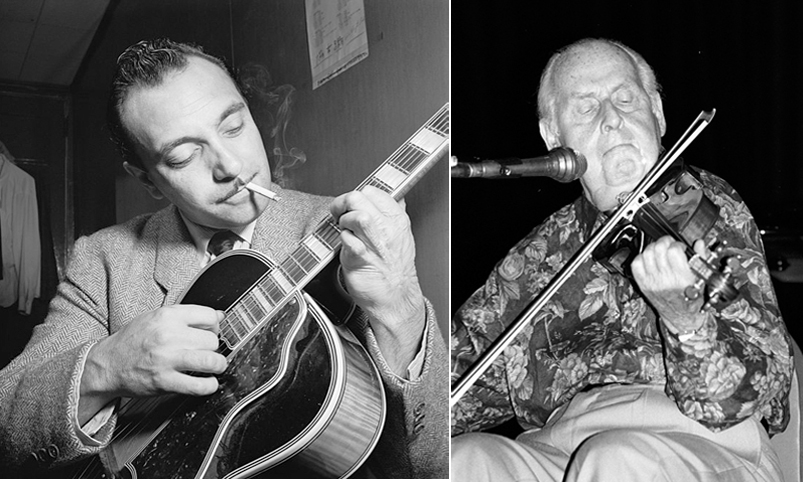
Django Reinhardt ; Stéphane Grappelli (later years) by William Gottlieb (Public Domain)
After a fire left two fingers on his left hand paralyzed, Reinhardt developed a radically new technique, using only his index and middle fingers for solos. The limitation birthed a style of fluid arpeggios and rapid chromatic runs.
Virtuoso violinist Stéphane Grappelli was for many years Reinhardt’s musical partner. His lyrical phrasing helped elevate jazz violin, proving that the instrument could swing—not just as a novelty, but as a lyrical voice equal to horns and guitars; dancing around the beat rather than attacking it head-on.
Seven Reinhardt tunes featuring Soikkeli’s guitar and Andy Stein on violin, show varying styles. “Minor Swing” embroiders with fast stitches. Flannel brushes (Alex Raderman) seem like whole cloth. Clarinet flutters, tenor sax whips and curls.
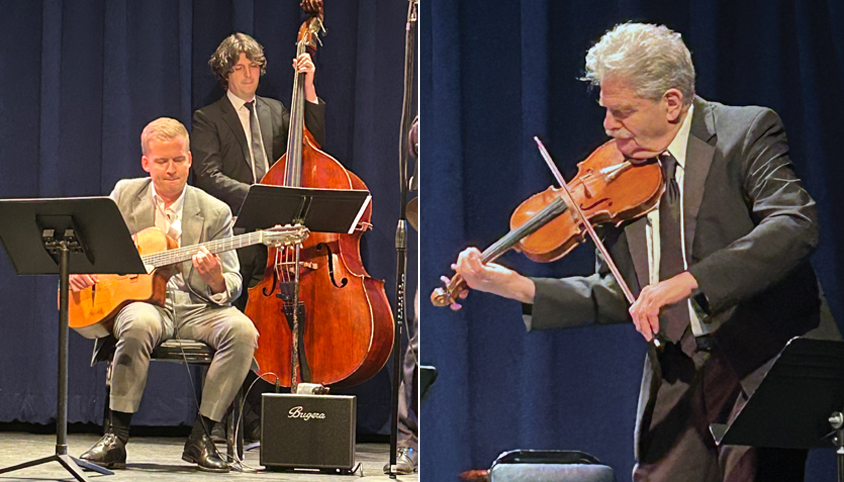
Olli Soikkeli’ (behind- Daniel Duke); Andy Stein
“Manoir de mes reves” (mansion of my dreams), “Ou est-tu, mon amour?” (where are you, my love?), and “Nuages” (clouds) are ballads. Guitar (Soikkeli) and bass (Daniel Duke) evoke hummingbird wings. Violin (Stein) is seductive. “Nuages”paints wet Paris streets at dawn, musicians straggling home; fading with refined, cursive flair.
Duke Ellington’s “Paris Blues” is represented by a clip from the film of that name with Louis Armstrong, pianist Aaron Bridgers, Paul Newman, and Sidney Poitier. The tune is jaded melancholy. French jazz musicians—especially arrangers and bandleaders—studied Ellington’s harmonic language and orchestration techniques.
Louis Guglielmi’s iconic “La vie en rose” is embraced by flute and clarinet with sassy violin. ‘Just lovely. In contrast, Philip Braham’s “Limehouse Blues” epitomizes musical stunt flying.
This evening’s highlight is original jazz scoring for the utterly charming, 1956 short film, The Red Balloon (written, produced, and directed by Albert Lamorisse) which we hear live as the film runs before us. Based on Debussy’s “Clair du lune”, accompaniment seamlessly interweaves styles, enhancing poetic action. ‘Wonderful! (Rent the film on Amazon Prime)
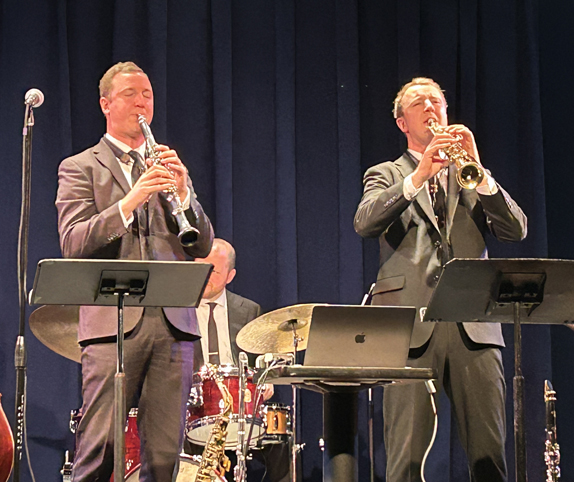
Will and Peter Anderson (in back-Alex Raderman)
“I Love Paris” (Cole Porter) and “Honeysuckle Rose” (Fats Waller) round up the era with panache.
“The French saved Jazz music.” Quincy Jones
The Anderson Brothers- Le Jazz Hot: How the French Saved Jazz
Band: Peter Anderson – tenor and soprano saxophone, clarinet; Will Anderson – alto saxophone, clarinet , flute, narration; Andy Stein – violin; Olli Soikkeli – guitar; Alex Raderman – drum set; Daniel Duke – bass
Performance Photos- Alix Cohen
Symphony Space 2537 Broadway at 95th Street https://symphonyspace.org/
The Andersons Next Show: Big Band Royalty at Birdland October 28, 2025
December 6th at Symphony Space The Anderson Brothers play Frank Sinatra
The Book: Songbook Summit: Fifteen Pioneers of American Sound by Will Anderson
The latest CD: “The Best of Berlin” on Arbors Records: https://arborsrecords.com/products/the-best-of-berlin-peter-and-will-anderson

